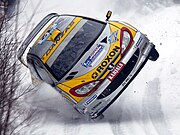Peugeot was involved in motorsport from the earliest days and entered five cars for the Paris-Rouen Trials in 1894 with one of them, driven by Lemaitre, finishing second. These trials are usually regarded as the first motor sporting competition. Participation in a variety of events continued until World War I, but it was in 1912 that Peugeot made its most notable contribution to motor sporting history when one of their cars, driven by Georges Boillot, won the French Grand Prix at Dieppe. This revolutionary car was powered by a Straight-4 engine designed by Ernest Henry under the guidance of the technically knowledgeable racing drivers Paul Zuccarelli and Georges Boillot. The design was very influential for racing engines as it featured for the first time DOHC and 4 valves per cylinder providing for high engine speeds, a radical departure from previous racing engines which relied on huge displacement for power. In 1913 Peugeots of similar design to the 1912 Grand Prix car won the French Grand Prix at Amiens and the Indianapolis 500. When one of the Peugeot racers remained in the United States during World War I and parts could not be acquired from France for the 1914 season, owner Bob Burma had it serviced in the shop of Harry Arminius Miller by a young mechanic named Fred Offenhauser. Their familiarity with the Peugeot engine was the basis of the famed Miller racing engine, which later developed into the Offenhauser, or "Offy" racing engine.
The company has had much success in international rallying, notably with the durable Peugeot 504, the four-wheel-drive turbo-charged versions of the Peugeot 205, and more recently the Peugeot 206. The 206 rally car had significant success in the rally championship, beating the Subaru Impreza, Ford Focus and Mitsubishi Lancer, cars which had traditionally dominated the sport. The 206 was retired practically unbeaten after several successful years, and replaced with the comparatively disappointing Peugeot 307 cc.
Throughout the mid-1990s, the Peugeot 406 saloon (called a sedan in some countries) contested touring car championships across the world, enjoying success in France, Germany and Australia, yet failing to win a single race in the British Touring Car Championship despite a number of podium finishes under the command of touring car legend Tim Harvey.
The British cars were prepared by Prodrive in 1996, when they sported a red livery, and by MSD in 1997-1998, when they wore a distinctive green and gold flame design. Initially the 406's lack of success was blamed on suspension problems, but it is now clear that the team was underfunded and the engine lacked power.[citation needed]
In 2001, Peugeot entered three 406 coupes into the British touring car championship to compete with the dominant Vauxhall Astra coupes. Unfortunately the 406 coupe was at the end of its product life-cycle and was not competitive, despite some promise towards the end of the year, notably when Peugeot's Steve Soper led a race only to suffer engine failure in the last few laps. The 406 coupes were retired at the end of the year and replaced with the Peugeot 307 - again, uncompetitively - in 2002.
Peugeot won the Manufacturers title of the World Rally Championship in 1985 and 1986 with its 205 T16. Peugeot won the manufacturers championship again in 2000, 2001 and 2002 with the 206. Peugeot won the grueling Paris Dakar Rally each year from 1987 to 1990.
In the 1990s the company competed in the Le Mans 24 Hours race, winning in 1992 and 1993 with the 905. It will be back in 2007, with the 908 powered by a diesel engine. Peugeot is also involved with the Courage C60 Le Mans racing team.
The company has also been involved in providing engines to Formula One teams, notably to McLaren in 1994, to Jordan for the 1995, 1996 and 1997 seasons, and to Prost for the 1998, 1999 and 2000 seasons. Peugeot's F1 interests were sold to Asiatech at the end of the 2000 season.
